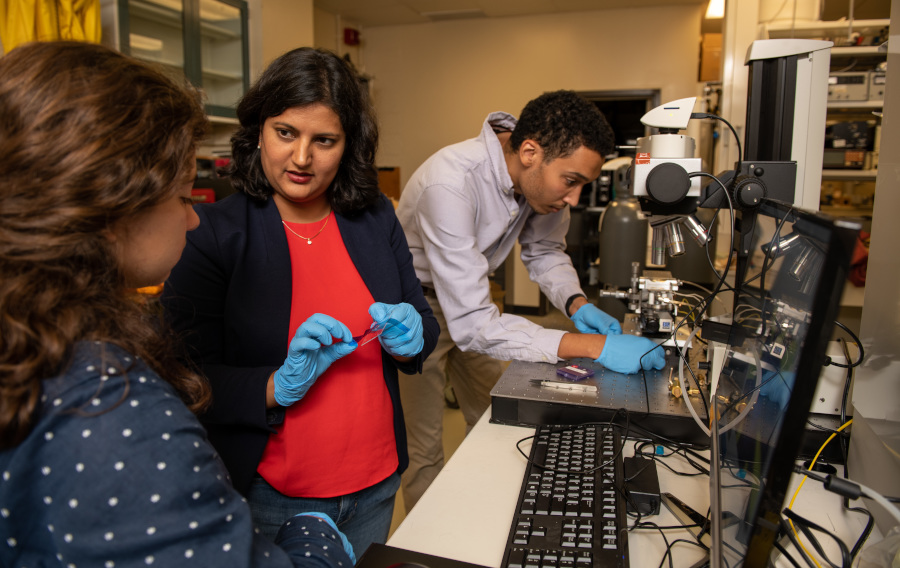Undergraduate Physics Research
Undergraduates at CMU have access to research at the scientific frontier, but in an environment that is welcoming and friendly for even beginners to make a big difference.
Undergraduate Research Areas
ASTROPHYSICS
EXPERIMENTAL
Leadership in the large galaxy surveys: Sloan Digital Sky Survey, Dark Energy Survey, HyperSuprime Cam, GAIA, Dark Energy Spectroscopic Instrument, and the Large Synoptic Survey Telescope. Specializing in analysis of near field cosmology, gravitational lensing, and gravitational waves.
THEORETICAL
Theories of the nature of dark matter, dark energy, and inflation. Galactic dynamics and more recently the rapidly growing field of gravitational waves and black holes. Particularly strong in high performance computing and machine learning applications to these areas.
BIOLOGICAL PHYSICS
EXPERIMENTAL
Investigations of cell cycle, growth regulation, and the related localization of cellular constituents as observed using fluorescent microscopy. Structure and function of biomembranes employing x-ray scattering and density measurements. In collaboration with faculty from other departments, NMR studies of the structure of proteins and optical microscopic studies of cell structure.
THEORETICAL
Theoretical and computational analysis of biological systems ranging in size scales from single molecules to entire organisms. Areas of focus include biomembranes, dynamic behavior of cell growth (both individual cells and within tissue), and protein localization within cells. Big picture questions about the nature of life.
CONDENSED MATTER AND APPLIED PHYSICS
EXPERIMENTAL
Specializing in fabricating and characterizing two-dimensional materials at low temperatures and varying magnetic fields; spin waves in these 2D systems; identifying new degrees of freedom that might be used as qubits in quantum computers. Some of these activities are carried out in active collaboration with other departments, institutes and centers in the science and engineering colleges.
THEORETICAL
Award-winning work on topological aspects of two-dimensional materials, with growing expertise on critical phenomena and symmetry-breaking. Close collaboration with experimentalists.
SUBATOMIC PHYSICS
EXPERIMENTAL
Study of the Higgs boson and searches for dark matter at the Large Hadron Collider at CERN. Heavy quark production and decay properties at Belle II. Leadership in the GlueX collaboration and long history of building instruments and operating experiments at Jefferson Laboratory. Leadership in neutrino experiments such as Katrin in Germany and the Coherent Neutrino Nucleus Interaction Experiment (CONNIE).
THEORETICAL
Effective field theories and their applications to experiments; collaboration with astrophysicists on models of the early universe; quantum entanglement and proposals for new degrees of freedom in quantum materials; approximate solutions of Einstein equations for gravitational waves. Nuclear models; nuclear reactions at medium and high energies; nuclear quark/gluon structure and interactions; QCD and weak interactions in nuclei, lattice gauge theory.
Student Research
Undergraduates can participate in research within the department for credit or pay, during the during the academic year, or during the summer. As part of their research our students have authored papers, presented at conferences, and even worked at the South Pole! Through these opportunities students not only gain essential professional and technical skills but contribute meaningfully to research efforts at the leading edge of their fields. Learn more about Physics Research at CMU
Why Physics at CMU?What Do Physicists Do?Degrees and Tracks: Your Options as a Physics Major
Recent Examples of Undergraduate Research Projects
- Analysis of the Replication Length of E. Coli Cells
- Band Structure Features of Monolayer WSc, Determined by Scanning Tunneling Spectroscopy
- Deep Forest: Neural Network Reconstruction of the Lyman-α Forest
- Deep Learning for Anomaly Detection in the CMS Detector at CERN
- Design of Fast Magnetostatic Logic Devices
- Fitting of Secondary Structural Motifs for Circular Dichroism Spectroscopy of Antimicrobial Peptides
- Energetic Analysis of Large Molecules using DFT & MBPT
- Further Developing Iteration Methods for 2D CVM Ising Model Alloys
- Growth of Sodium Bismuth through Molecular Beam Epitaxy
- Inflationary Gravitational Waves in Nonstandard Cosmologies and the NANOGrav Results
- Gravitational Waves from the Early Universe: Sources and Detection Prospects
- Monte Carlo Simulation of Neutron-Detector Calibration
- Survey of Galaxy Dark Matter Distribution
- Validation of Simulated Neutrino Flux at a Stopped-Pion Neutrino Source
- Variational Mean-Field Model of the Ground State of an Electron-Hole Gas in a Semiconductor
Get started!
Please first contact the Director of Undergraduate Affairs if you are interested in doing research during the semester with one of our faculty members. We will assist you in finding a suitable faculty member and research project. Also check out the Gelfand Center's STEM Career Explorations and 360° Lab Tours with Prof. Alison and Prof. Tristram-Nagle to get a sense of what it means to conduct research as an undergraduate!
